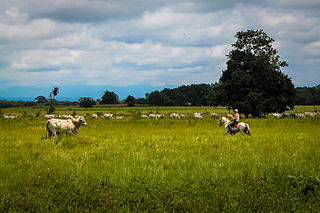
José Antonio Páez Herrera was a Venezuelan politician and military officer who served as the president of Venezuela three times. The first as the 5th president from 1830 to 1835, the second as the 8th president from 1839 to 1843, and the third as the 15th president from 1861 to 1863. He fought against the Spanish Crown for Simón Bolívar during the Venezuelan War of Independence. Páez later led Venezuela's independence from Gran Colombia.

Valencia is the capital city of Carabobo State and the third-largest city in Venezuela.

Carabobo State is one of the 23 states of Venezuela, located in the north of the country, about two hours by car from Caracas. The state capital city is Valencia, which is also the country's main industrial center. The state's area is 4,369 km2 (1,687 sq mi) and as of the 2011 census, had a population of 2,245,744.

Barinas State is one of the 23 states of Venezuela. The state capital is Barinas.

Portuguesa State is one of the 23 states of Venezuela. Located in the west of the Republic, it is often considered the "breadbasket of Venezuela" for the large amount of agricultural products produced there. The state is bordered by the state of Lara to the north, to the east by Cojedes, to the west by Trujillo and to the south by Barinas.

Maturín is a city in Venezuela, the capital of the Venezuelan state of Monagas and a centre for instrumental exploration and development of the petroleum industry in Venezuela. The metropolitan area of Maturín has a population of 401,384 inhabitants. Maturín is also a busy regional transportation hub, connecting routes from the northeastern coast to the Orinoco Delta and the Gran Sabana.

Barinas is a city in west central Venezuela. According to the 2011 census, its population is 353,442. It is the capital of the Barinas Municipality and the State of Barinas. The city of Barinas is known as the capital of the Llanos.

Municipalities of Venezuela are subdivisions of the States of Venezuela. There are 335 municipalities dividing the 23 states and the Capital District.

Portuguesa Fútbol Club, usually known simply as Portuguesa, is a Venezuelan professional football club based in Acarigua, that competes in the Primera División.

José María Córdova Muñoz, also known as "Hero of Ayacucho", was a General of the Colombian army during the Independence War of Colombia, Perú, and Bolivia from Spain.

Victoria Sánchez is a Venezuelan conductor, actress, singer, and pianist from El Sistema of Venezuela. She is the music director and conductor of ALMAS, Sinfónica de Jóvenes Latinoamericanas.
The Pastora de los Llanos were a baseball club which played in the Venezuelan Professional Baseball League between the 1997–98 and 2006-07 seasons. They were based in the cities of Acarigua and Araure in Portuguesa, and played its home games at Estadio BR Julio Hernández Molina in Araure.
The Roman Catholic Diocese of Acarigua–Araure is a Latin suffragan diocese in the ecclesiastical province of the Metropolitan of Barquisimeto in Venezuela.
German Venezuelans are Venezuelan citizens who descend from Germans or German people with Venezuelan citizenship. Most of them live in Caracas, Maracaibo, Valencia, Colonia agrícola de Turén, El Jarillo, and Colonia Tovar where a small-reduced and decreasing minority of people speak the Colonia Tovar dialect, a German-derived dialect from their ancestry, and the Spanish language.
There have been four different professional baseball clubs in Venezuela that have played under the name Pastora. These teams have been established in the northwest of the country, particularly in the states of Zulia and Acarigua, and have played in different leagues between 1931 and 2000.
The Our Lady of Corteza Cathedral also called Cathedral of Acarigua-Araure, or Parish Cathedral of Our Lady of Corteza is a religious building belonging to the Catholic Church and is located in the city of Acarigua-Araure in Portuguesa state in the plains region South American country of Venezuela.

The State of Venezuela was the official name of Venezuela adopted by the constitution of 1830, during the government of José Antonio Páez. The name was maintained until 1856 when in the constitution promulgated in that year it changes the official name of the country to Republic of Venezuela. In the Constitution of 1864, the United States of Venezuela was established.
The 2018 Primera División season, officially Liga de Fútbol Profesional Venezolano or Liga FUTVE, was the 37th professional season of Venezuela's top-flight football league. Monagas were the defending champions, but did not qualify to the Serie Final, after being eliminated in the regular season of the Torneo Apertura and by Caracas in the quarter-finals of the Torneo Clausura.

A group of inmates were involved in a prison riot on 24 May 2019 in the police station cellblocks in Acarigua, Portuguesa state, Venezuela. The riot allegedly began when inmate Wilfredo Ramos was killed following ten days of protests against the denial of visits by relatives.


















